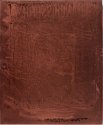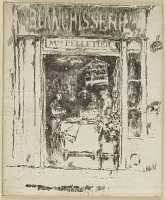Etchings Institutions search term: obach
Mme Pelletier, Blanchisserie, Paris | ||
| Number: | 481 | |
| Date: | 1897/1898 | |
| Medium: | etching and drypoint | |
| Size: | 182 x 151 mm | |
| Signed: | butterfly at right | |
| Inscribed: | no | |
| Set/Publication: | no | |
| No. of States: | 1 | |
| Known impressions: | 1 | |
| Catalogues: | K.438; M.438 | |
| Impressions taken from this plate (1) | ||

Recto, above; verso, below:

The copper plate bears the oval maker's stamp: 'C. SERVANT / PLANEUR / 45, B DES GDS AUGUSTINS'. This is found on a small group of etching plates, namely
Confections pour Dames
[475],
Mme Pelletier, Blanchisserie, Paris
[481],
Café Corazza, Paris
[484],
Antony's Print Shop, Rue de Seine
[477],
Polichinelle, Jardin du Luxembourg
[467],
Boulevard Poissonière, Paris
[483], The Band, Luxembourg Gardens
[466], Under the Statue, Luxembourg Gardens
[464] (all of which date from 1894 or later in the 1890s), and Flaming Forge
[490] and
Sleeping Child, Ajaccio
[488] (both of which date from 1901). It is the same size as The Band, Luxembourg Gardens
[466], which is known only from the copper plate.
The envelope containing the copper plate of Mme Pelletier, Blanchisserie, Paris contains a note of the title, and also an older note on a label pasted on the envelope, which reads 'Blanchisseuse "Pelletier" To be destroyed'; the last phrase was overwritten in ink, 'To be destroyed / cleaned off.' This note dates from Whistler's life-time, but the order was not carried out. 9
9: Note on label pasted on envelope, Hunterian Art Gallery.
The plate was in Whistler's studio at his death, and was bequeathed to Rosalind Birnie Philip (1873-1958) who gave it to the University of Glasgow in 1935. It was cancelled posthumously with a diagonal line across the lower left corner.
